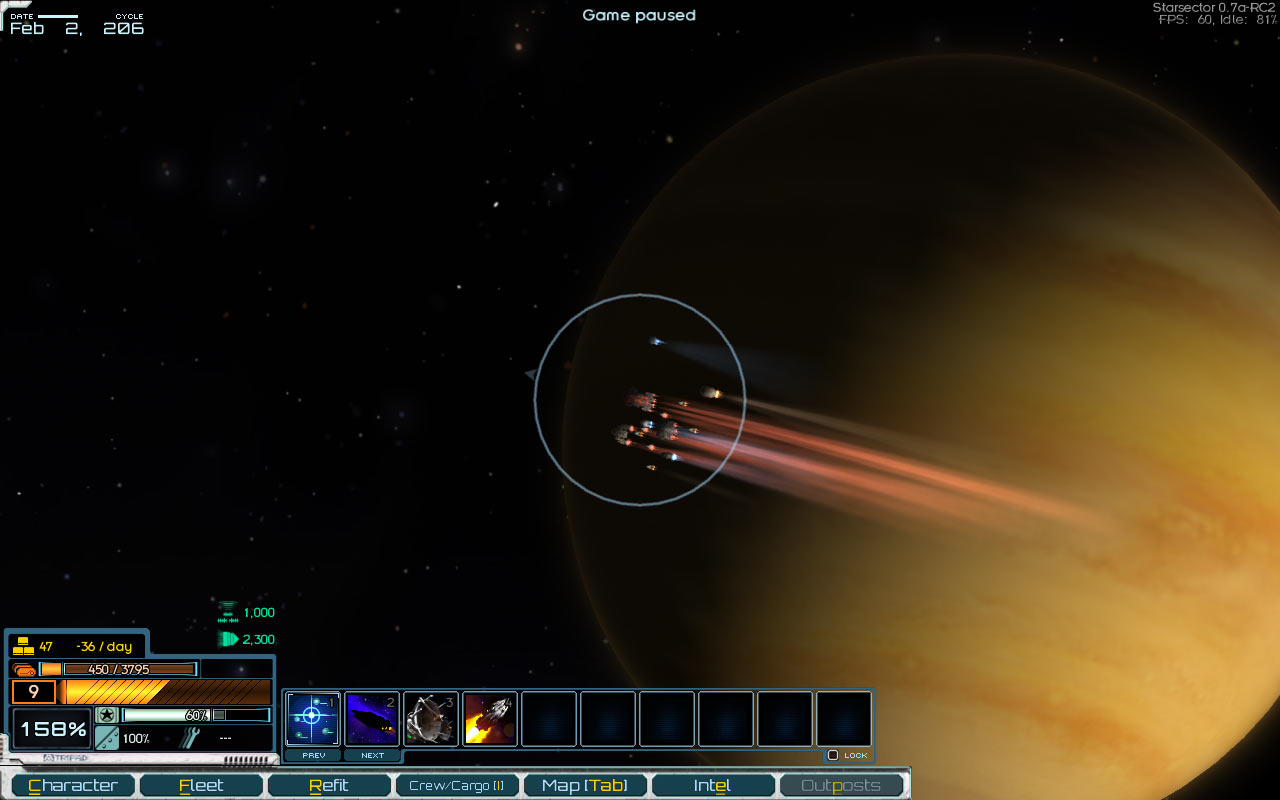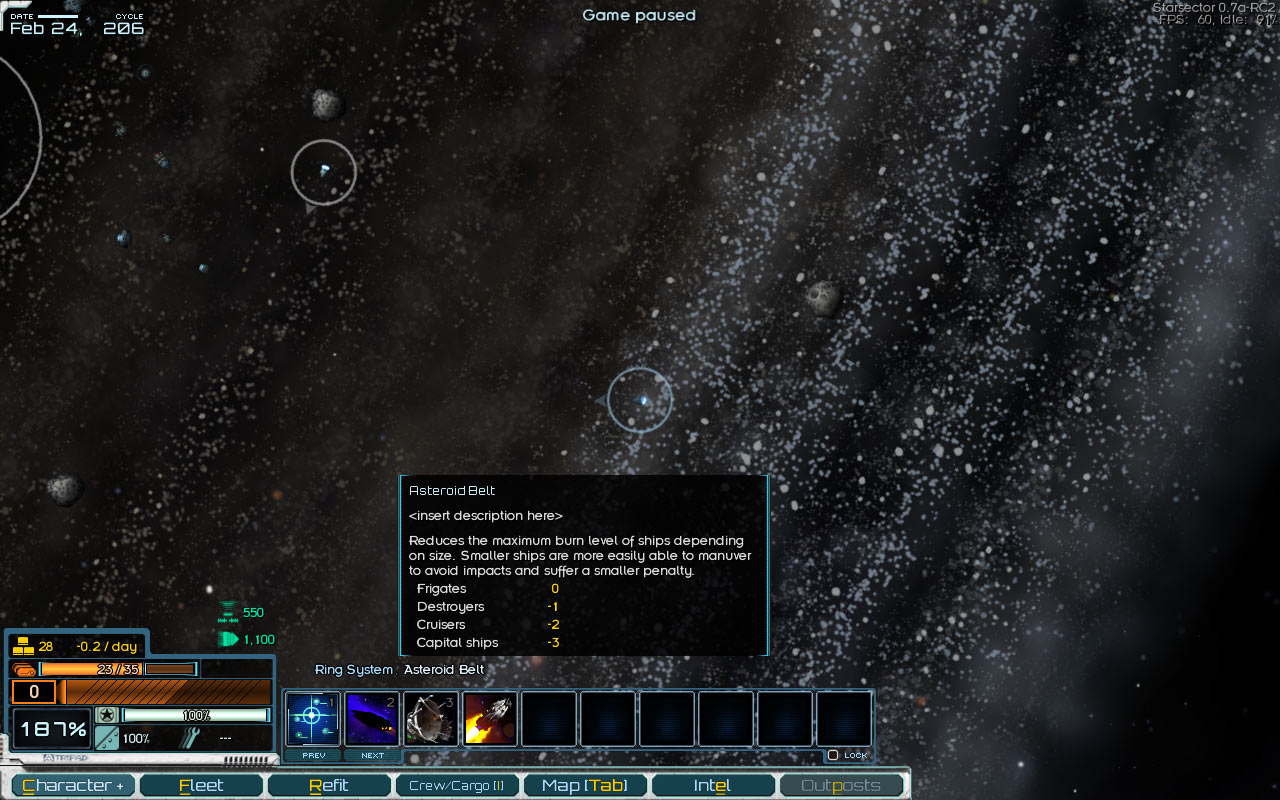Terrain
In the spirit of continuing to liven up the campaign layer of the game (and also knocking out a swath of high-level features in the most-straightforward-possible way), I’ve been working on terrain in the past couple of weeks.
But first, in the name of putting something shiny before the break: fleet contrails!
In addition to being eye candy, these also serve as visual indicators of ability use. For example, using the “Emergency Burn” ability brightens up and extends the trail, while activating “Go Dark” reduces its length and duration.
With that, onwards to terrain. What does it do? It affects fleets that are in it – their speed, detection range, that sort of thing. Why is it there? As usual, part of the answer is “to give the player an opportunity to make interesting decisions”. Without terrain, if you’re being pursued, running one way or another is pretty much the same.
If you might lose your pursuers in an asteroid belt, or hide inside a nebula, then you’ve got reasons for going one way or another. Beyond that, adding terrain to star systems gives them more personality and makes them more interesting.
Nebula
What’s space without nebulas? A silly question, because of course there are nebulas and this hypothetical situation can’t possibly come up.
A fleet inside a nebula is more difficult to detect, but its own sensors are not affected, so the edge of a nebula is a good place to hide while still being able to keep an eye on the surrounding area.
Being inside a nebula also slows ships down, with smaller ships being affected a lot more. Mass-to-cross-section ratio and all that, right? Combined with some very vigorous hand-waving. Thus: ships of all size classes are on the same footing, which favors larger ships – fleets consisting of smaller (and probably weaker) ships would find it more difficult to get away.
(You might be thinking, “but wait, doesn’t this contradict the in-combat nebula effects, which slow down larger ships more?”. You’d be right – the in-combat effects of the nebula are now different and in line with the campaign effects.)
Initially, I was thinking of nebulas as being relatively small clouds, sprinkled here and there. Luckily, David was thinking on a grander scale, and a few optimizations later, we’ve got much more majestic nebulas that span entire star systems.
Asteroid Belt
A counterpoint to the nebula, an asteroid belt slows down larger ships more than it does small ones, which presumably have an easier time adjusting their course to avoid collisions. This also requires hand-waving, because a real asteroid belt is a rather empty place, but we’re not going to worry about that too much.
Gameplay-wise, an asteroid belt is a good place for smaller craft to lose heavier-class pursuers, which has the right feel to it.
Ring System
The rings around a Saturn-like gas giant, or the protoplanetary disk circling a young star (see: the Magec star system). There’s a lot of material floating around, but let’s say the individual chunks are not generally big enough to threaten ships (unlike an asteroid belt), but it’s also not uniformly dense enough to slow them down (unlike a nebula). All this material does, however, produce an amazing amount of sensor readings, making it easier for real contacts to get lost among the noise. So: stationary fleets are more difficult to detect.
This makes a ring system a good place to lie in ambush – and, equally, a dangerous place to approach. Another option here might be to reduce the sensor range of fleets inside a ring system, but that would make a ring system a purely negative piece of terrain – somewhere you just don’t want to be, period – which seems less interesting.
(Incidentally, the way this is presented – going from in-fiction justification to gameplay effect – is the opposite of the design process. The first step was figuring out what properties the terrain should have that both work mechanically and that the player would expect. There are some concessions to making the mechanics plausible for what the terrain is, but it’s more in the name of matching player expectations than any desire for “realism”.)
Corona
The atmosphere of a star, extending for some distance beyond the star itself. Ships can tolerate being inside, but lose combat readiness at a steady, and alarming, rate. AI fleets will avoid it under most circumstances; this makes going into the corona useful as a last-ditch escape measure. It also adds an extra layer of unpleasantness to running out of fuel in hyperspace, drifting towards a nearby star, and coming out on top of it. Which is good – some crisping definitely seems in order here, and now it’ll actually happen.
Dev Status
Implementation-wise, these terrain types are functional, but there’s still some cleanup to do. I also want to take a look at more clearly conveying the outer extent of a star’s corona – right now, you can’t really see it, although your ships do start glowing, if rather subtly. That’s precisely the sort of graphics-tweaking that isn’t even guaranteed to produce satisfactory results, and can take a long time to nail down if it does, but I want to give it a shot.
Then there’s utilizing the terrain types fully in the campaign (i.e. content creation), and we’ve also been talking internally about one or two other terrain types that may or may not make the cut.
Finally, while the fleet AI is already aware of terrain to some extent, there’s more tweaking to do there as well.
So, as usual: done enough to write a blog post about, but not “done” done.
Comment thread here.
Tags: asteroid belt, campaign, contrail, corona, crisping, fleet, nebula, ring system, star













